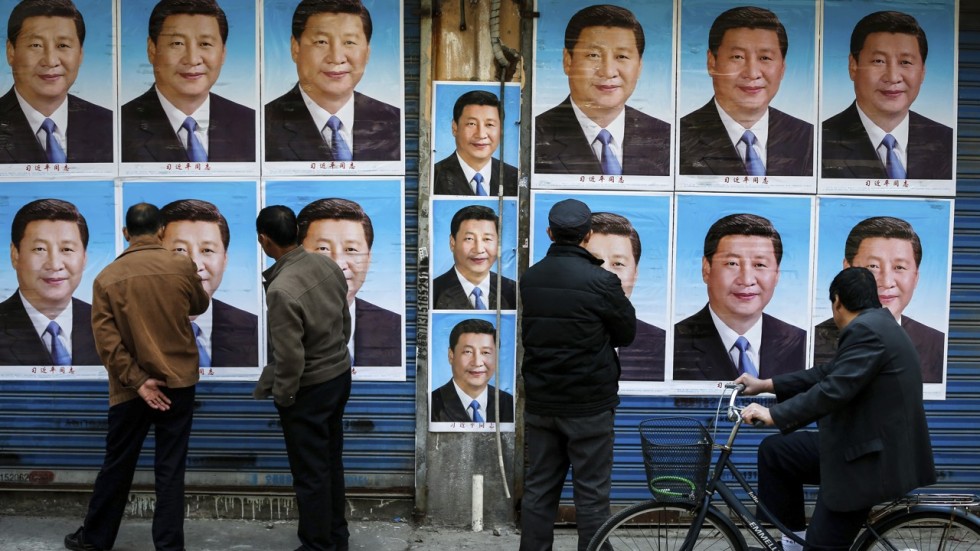By Chauncey Jung

Posters of Chinese dictator Xi Jinping are plastered on a wall in Shanghai in March 2016.
Anyone who follows Chinese state media coverage can see that Chinese propaganda is inconsistent. From the changing strategy on Xi Jinping’s image to its stance on patriotic films, Chinese propaganda does not follow a consistent guideline.
Chinese officials seemingly decide in an arbitrary and random fashion how the nation is presented, both to a domestic audience and to the outside world.
The Chinese government’s public communication appears aimed only at meeting short-term goals. But contradictions arise without a coherent strategy.
The Chinese government’s public communication appears aimed only at meeting short-term goals. But contradictions arise without a coherent strategy.
There have been occasions when Chinese propaganda has adversely affected the country’s image, or triggered reactions that were opposite to what the regime intended.
Without a clear, modern and consistent strategy, Chinese propaganda will only hurt the nation’s image.
Take for example the propaganda effort surrounding Xi.
Without a clear, modern and consistent strategy, Chinese propaganda will only hurt the nation’s image.
Take for example the propaganda effort surrounding Xi.
In his earlier public appearances, the Chinese president was portrayed as an amicable leader whom the people could easily relate to.
In 2013, he showed up at a Beijing steamed bun shop to order food alongside ordinary Chinese.
In 2014, Chinese propaganda officials created the term “Uncle Xi” (Xi Dada) and “Auntie Peng”, for first lady Peng Liyuan.
In these early years, propaganda officials set the tone for Xi’s persona as a caring leader who is close to the people.
However, his image has changed dramatically.
However, his image has changed dramatically.
The propaganda apparatus today lionises Xi as a leader second in stature only to Mao Zedong.
It has encouraged the growth of a personality cult surrounding “Xi Dada”, and named him the undisputed “core” leader of party and country.
Out goes the personable uncle, and in comes the strongman leader.
Inevitably, censors are deployed to scrub out propaganda associated with Xi the caring leader, including articles on his visit to the steamed bun shop and interviews claiming he carried 100kg of wheat as a youngster.
Such inconsistencies – driven by a propaganda strategy that is increasingly at odds with the more educated and more globally aware Chinese population today – create significant problems in controlling and managing public opinion.
Inevitably, censors are deployed to scrub out propaganda associated with Xi the caring leader, including articles on his visit to the steamed bun shop and interviews claiming he carried 100kg of wheat as a youngster.
Such inconsistencies – driven by a propaganda strategy that is increasingly at odds with the more educated and more globally aware Chinese population today – create significant problems in controlling and managing public opinion.
Every time propaganda officials change their tune, people see the contradictions and question the regime’s credibility.
Xi’s changing personas, for example, have made people more aware that the government has turned more authoritarian in the past five years, and have became fodder for critics to signal their discontent. Thus, when the government amended the constitution earlier this year to abolish presidential term limits, thereby allowing Xi to potentially rule for life, Chinese internet users turned the propaganda term Xi Dada into memes in protest.
Instead of stabilising the regime, as intended, the propaganda campaign is undermining it.
The government’s propaganda effort aimed at a foreign audience is similarly flailing.
Xi’s changing personas, for example, have made people more aware that the government has turned more authoritarian in the past five years, and have became fodder for critics to signal their discontent. Thus, when the government amended the constitution earlier this year to abolish presidential term limits, thereby allowing Xi to potentially rule for life, Chinese internet users turned the propaganda term Xi Dada into memes in protest.
Instead of stabilising the regime, as intended, the propaganda campaign is undermining it.
The government’s propaganda effort aimed at a foreign audience is similarly flailing.
Since Xi came to power in 2013, China has promoted its “Chinese dream” of national rejuvenation, built on the foundation of the “Four Self-confidences” (faith in its own system, path, theory and culture).
This became the basis for its resistance to Western ideology, and its assertiveness, even aggression, towards perceived enemies.
Its goals were twofold: to show the world a unified, strong and modern China, and to showcase the confidence of the government by bashing countries with which it has disputes.
Its goals were twofold: to show the world a unified, strong and modern China, and to showcase the confidence of the government by bashing countries with which it has disputes.
But this strategy has backfired.
By allowing the production of such videos as the Seven Sins of India, published last year by New China TV, the official YouTube channel of Xinhua News Agency, at the height of China’s border stand-off with India, Beijing has only created a negative image of itself.
By allowing the production of such videos as the Seven Sins of India, published last year by New China TV, the official YouTube channel of Xinhua News Agency, at the height of China’s border stand-off with India, Beijing has only created a negative image of itself.
By using racist and disrespectful language and tone in such blatant propaganda, the Chinese government showed its ignorance of the social conventions that bind the international community.
China’s propaganda strategy in its trade war with the US has also been a mess, with official statements alternately threatening a fight to the end with US hegemony and seeking cooperation to advance the global interest.
China’s propaganda strategy in its trade war with the US has also been a mess, with official statements alternately threatening a fight to the end with US hegemony and seeking cooperation to advance the global interest.
This confuses others about China’s true intent.
Without a clear strategy, Chinese strategic intent seems equivocal and lacks focus.
Without a clear strategy, Chinese strategic intent seems equivocal and lacks focus.
Recently, for example, China revelled in the release of Amazing China, a jingoistic documentary film celebrating the country’s achievements over the past five years.
Yet now, to minimise the impact of the trade war, the regime even began to play down its “Made in China 2025” policy, a key plank for advancing the nation’s technological reach.
Unlike China’s tightly controlled internet, the free flow of information in other, more democratic, parts of the world means people can easily track Beijing’s inconsistencies, making its propaganda efforts futile in shaping international public opinion.
This only shows that Chinese officials have little understanding of how journalism works in countries with freedom of speech.
Unlike China’s tightly controlled internet, the free flow of information in other, more democratic, parts of the world means people can easily track Beijing’s inconsistencies, making its propaganda efforts futile in shaping international public opinion.
This only shows that Chinese officials have little understanding of how journalism works in countries with freedom of speech.
They appear to assume that the world operates the way China does; they believe that deleting content and stopping journalists from publishing stories is a more effective way to support the regime’s actions than crafting a reasonable argument to convince and persuade critics.
China spends billions of dollars to ensure the country has a positive image.
China spends billions of dollars to ensure the country has a positive image.
But unless it updates its style of public engagement, it will be extremely difficult for the country to achieve its goal of making the world see beyond the regime’s abuses of human rights, freedom of speech, and other undemocratic practices.
The problem is that China does not believe in constructive criticism.
The problem is that China does not believe in constructive criticism.
Rather, the regime bets on silencing and repressing those who are eager to speak.
